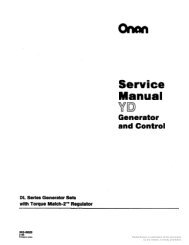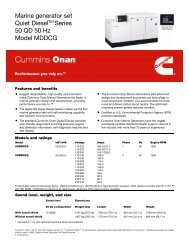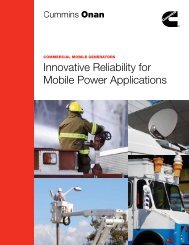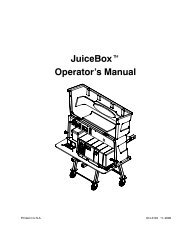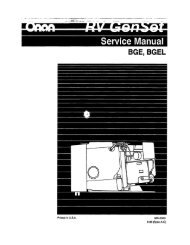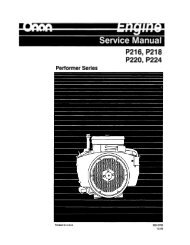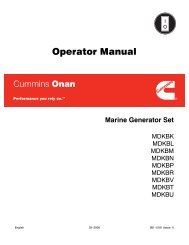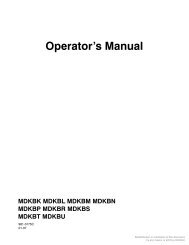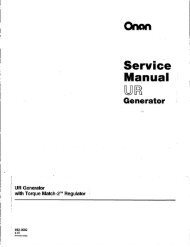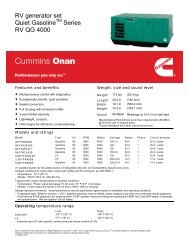Operation and Installation - Cummins Onan
Operation and Installation - Cummins Onan
Operation and Installation - Cummins Onan
Create successful ePaper yourself
Turn your PDF publications into a flip-book with our unique Google optimized e-Paper software.
WIRING CONNECTIONS<br />
See the appropriate Outline Drawing (beginning on<br />
Page A-1) for wiring connections between the components<br />
of the system. Also refer to the wiring schematic<br />
on Page A-6.<br />
AC Output Connections<br />
AC power output is through four Type CCXL conductors<br />
12 ft (3.6 m) long in rain-tight flexible conduit.<br />
Conductors <strong>and</strong> conduit are sized according to<br />
Table 1. Refer to the wiring schematic on Page A-6.<br />
TABLE 1. WIRING GAUGE AND CONDUIT SIZE<br />
KW Wire Gauge Conduit Size<br />
6 & 8 12 AWG 1/2 inch<br />
10 10 AWG 3/4 inch<br />
15 8 AWG 1-1/4 inch<br />
Control <strong>and</strong> Monitoring Connections<br />
All wiring interconnections between components of<br />
the system are done with 15 foot (4.3 m) long harnesses<br />
with sealed connectors (Table 2) that match<br />
the connectors on the component leads.<br />
TABLE 2. WIRING HARNESSES<br />
HARNESS<br />
CONNECTIONS<br />
338-4084 Genset to Remote ON/OFF Switch<br />
338-4085 Genset to Battery<br />
338-4086 Genset to Pump Actuator<br />
338-4087 For Display Power (from Genset)<br />
338-4088 For Oil Temperature Display from Sensor<br />
338-4089 For AC Display from Genset<br />
Wiring Methods<br />
Follow the National Electrical Code (USA) or Canadian<br />
Electrical Code, as required. Especially note<br />
the following:<br />
1. Have a trained <strong>and</strong> experienced electrician supervise<br />
<strong>and</strong> inspect the installation of all AC wiring.<br />
2. Provide overcurrent protection as required at<br />
the vehicle AC distribution panel. See Article<br />
445, NFPA No. 70 (USA) or Part 1, Section 14<br />
of C22.1 (Canada).<br />
3. Install vibration-proof switches <strong>and</strong> controls<br />
that won’t open <strong>and</strong> close circuits when the vehicle<br />
is in motion.<br />
4. Provide ground fault circuit interrupters<br />
(GFCIs) for all convenience power receptacles.<br />
5. Route AC power wiring <strong>and</strong> remote control wiring<br />
separately.<br />
6. Seal all conduit openings into the vehicle interior<br />
to keep out vehicle engine exhaust. Apply silicone<br />
rubber or equivalent sealant inside <strong>and</strong><br />
outside each conduit connector. (Flexible conduit<br />
is not vapor-tight <strong>and</strong> will allow exhaust gas<br />
to enter along the wires if not sealed.)<br />
WARNING EXHAUST GAS IS DEADLY!<br />
Seal all wiring openings into the vehicle interior<br />
to keep out exhaust gas.<br />
7. Bond the genset <strong>and</strong> all connected AC <strong>and</strong> DC<br />
equipment <strong>and</strong> controls to a common grounding<br />
point in accordance with applicable codes.<br />
WARNING Faulty grounding can lead to<br />
fire or electrocution, resulting in severe personal<br />
injury or death. Grounding must be in<br />
accordance with applicable codes.<br />
6



